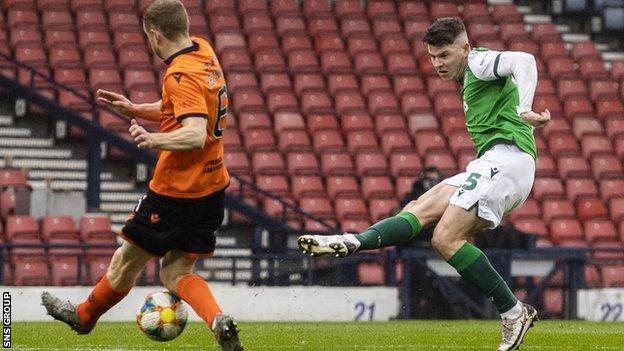Scottish Cup final: Hibs v St Johnstone at Hampden will be watched by 600 fans
- Published

Hibs beat Dundee United 2-0 at an empty Hampden to reach the final
Hibernian head coach Jack Ross says the decision to allow just 600 fans into his side's Scottish Cup final against St Johnstone is "baffling".
Permission was granted on Thursday to allow spectators at the 22 May game.
The Scottish FA had applied to the Scottish Government to have 2,000 inside the 52,000-capacity ground.
"It would be nice to have a clear explanation," said Ross. "I know there have been reasons offered for it but it is difficult to comprehend."
The Easter Road club are to ballot 240 tickets after keeping 60 of their allocation for for players and staff.
St Johnstone have yet to confirm their plans, with manager Callum Davidson saying: "Probably we would all like a little bit more but those are the rules, that is what they have decided and we have to abide by it."
However, first minister Nicola Sturgeon announced later on Friday afternoon that Glasgow would be remaining in Level 3 restrictions for at least another week, which makes it unclear whether fans will still be able to attend the final a week on Saturday.
Earlier in the week, Uefa had acceded to a request to have a crowd at the game, which comes while the stadium is under their control in the build up to Euro 2020.
The Scottish FA proposal was submitted following the seating template used for the Euros at Hampden.
That would have housed all fans in the lower part of the south stand, with the rest of the stadium believed to be out of commission due to preparatory work for the delayed tournament.
However, the Scottish government says two-metre physical distancing will be needed, rather than the 1.5m that will allow 12,000 fans at the Euros in June.
'A missed opportunity'
"I'm sure people will, in the aftermath of anyone complaining, point out why they are right and we are wrong," added Ross. "I do find it baffling to be honest.
"From Monday, and I apologise if I'm wrong, it's one-metre distancing in an indoor hospitality venue, yet two-metre distancing outside. I'm a layman when it comes to science but I don't quite get that.
"In the not too distant future, there's going to be an awful lot more people than 600 inside the same stadium. I just feels like a missed opportunity to have more people participating in something that means an awful lot."
As of Monday, at least 500 fans people can attend outdoor events in Scotland without specific permission.
That includes all of next week's SPFL play-off finals, all of which will take place in stadiums significantly smaller than Hampden.
The Scottish FA had said in April that no supporters would be inside the national stadium for the final.
It was initially claimed that the preparatory work for the Euros would prevent Hampden receiving a safety certificate from the local authorities, then Uefa's management of the stadium was cited as an issue.
Why are only 600 fans allowed?
BBC Scotland's chief sportswriter Tom English
Confusion has reigned since the Scottish FA announced that only 600 fans will be allowed into Hampden. That's 600 in a 52,000-seat stadium.
The head-scratcher comes in the fact that much, much smaller stadiums in Scotland - Dundee, Greenock Morton, Airdrieonians and Brechin City - will be allowed 500 fans for the divisional play-offs.
How come Hampden can only have 100 more fans than those grounds? And how come Hampden - only three weeks later - can suddenly have 12,000 at the Euros?
The available capacity for Euros matches is 12,000, with social distancing set at 1.5m. The Scottish FA applied to government for 2000 fans at the cup on the same operational plan.
Given Uefa building works are ongoing at Hampden, the available capacity for the final is actually between 8,000-12,000, with the realistic number a lot closer to the 8,000. Again, that's at 1.5m distancing.
But the government has insisted on two metres. According to the Scottish FA, the government only revealed this after their application was submitted on the basis of 1.5m. There is some tension between the two around this.
At 2m, the maximum number of seats falls to between 4,000 and 5,000. So a long way short of the initial 52,000.
All of this, ultimately, means that the 600 tickets secured is between 12% and 15% of the available capacity.